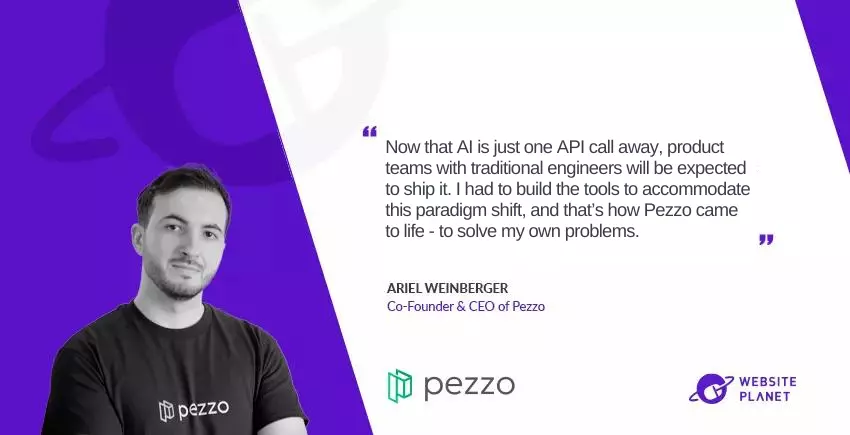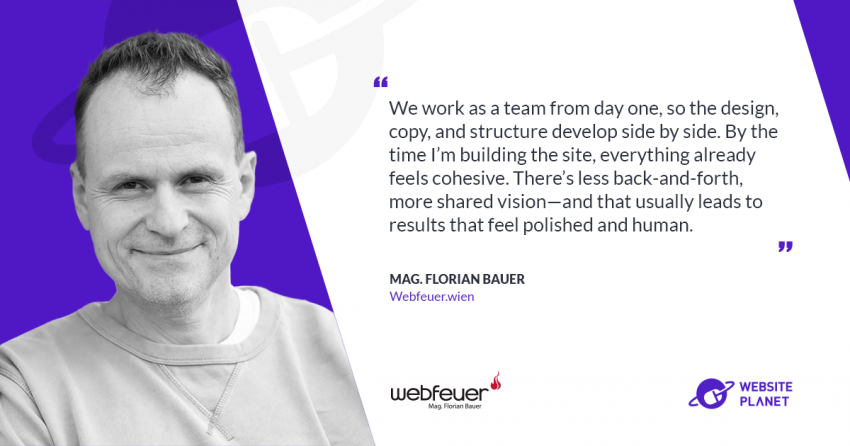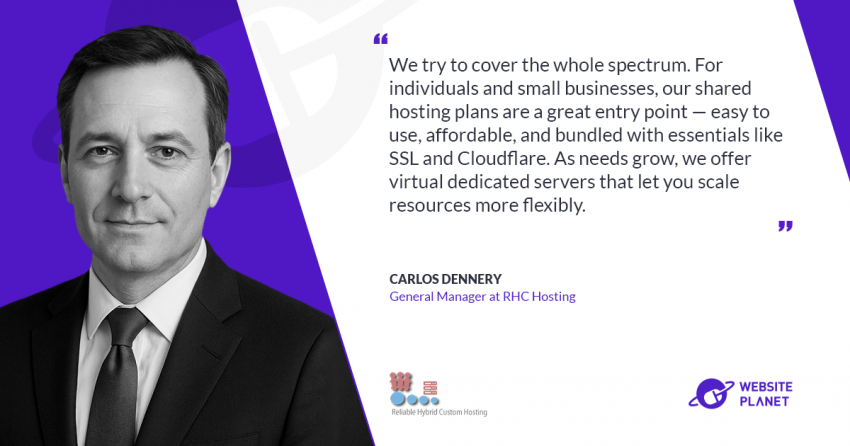In this interview series, Website Planet is talking to executives from the best online businesses, to cut the fluff and learn what it really takes to create a successful website and online business like they did.
My guest today is Ariel Weinberger, Co-Founder & CEO of Pezzo, an open-source platform downloaded 630k+ times that simplifies the process of testing, monitoring, and shipping AI features quickly and efficiently. A great (and free) solution in times when AI models are greatly capable but the tooling around them greatly sucks.
Ariel was previously VP R&D at Amplication and Engineering Manager at Serverless Inc., and has extensive experience in developer tools, productivity boosters, distributed systems, scalability, observability, maintainability, Node.js, cloud-native, and Serverless technologies, as well as micro frontends.
He is also a best-selling instructor on Udemy with over 170,000 students.
To start, share your story with our readers. How did your professional journey begin, what challenges have you faced, and what achievements are you most proud of?
I started as a self-taught developer. I always knew I wanted to do this, I loved coding since I was very young. But I was pretty bad at school so university wasn’t an option – I simply couldn’t get admitted to any. So I spent sleepless nights in my early 20s learning how to code and build frontends, backends and cloud operations for my projects. I was pretty much full-stack from Day 1 and very practical.
When I started working in the industry, I was really struggling with the imposter syndrome (and I still do to this day). Everyone around me had a lot of experience, advanced degrees, and knowledge in Computer Science. This always made me feel like I have to go the extra mile, and it’s a sort of culture I’ve developed – to always aim to be the best at whatever I do.
At some point, my manager told me – “If you can teach it, you know it”. It sunk really deep, and I decided to start making online courses on Udemy, where I learned everything myself. It was a shot in the dark, but fast forward a few years later, my courses are bestsellers with over 170,000 students worldwide and around 60,000 hours watched per year. It helped quite a bit, but the imposter syndrome never goes away. Maybe it’s a good thing that helps me keep myself in check.
I’ve climbed the career ladder pretty quickly. I was always told by my business peers that “it’s so pleasant to work with a developer who understands the business and communicates so well”. I was just lucky to work at amazing companies where culture, communication and diversity were core values. Very early on in my career I prioritized soft skills over hard skills. I found myself in leadership positions at companies many of us know, such as Platform Engineering Manager at Serverless Inc., Head of Engineering at Abcam, and a few others.
My greatest challenge was as Head of Engineering at Abcam. It was a very traditional biotech company (25 years old, traded in the NASDAQ) with the goal of doing a complete digital transformation. I was engineer #1 in the transformation process and was tasked with setting up everything engineering-related. I’ve hired 70 engineers in the first year, and the most challenging part was to get the absolute top talent to work at a company that does life sciences.
Engineers often look up to companies they can better understand, such as Uber, Amazon, etc. But supporting life scientists in finding a cure to Alzheimer’s disease is much more rewarding. I had to find a way to onboard engineers in a way that bridges the gap between their love for software development and life scientists so we can grow quickly. That was very challenging but super fun. *
* P.S. Last year, Abcam was sold to a private equity firm for $6 billion USD. Great success!
What pain point(s) do you solve for your customers? What was the “aha Moment” that led to the idea? Can you share that story with us?
I came up with the idea for Pezzo when I built a side project with friends. It was called Resumator, and the idea was to use the first iterations of Generative AI (GPT 3 at the time) to help job seekers maximize their chances by tailoring their resumes and cover letters to specific job descriptions, using AI.
We delivered something that worked pretty well in no time. But the process was painful. We were two full-stack developers and a product manager. We were all very experienced, and we immediately noticed some fundamental pains with Generative AI that pretty much all “traditional” developers would face as soon as they start adoption:
Reliability
As a developer, I am used to having tests in my code. But AI is probabilistic, rather than deterministic. I want to be able to make changes to my prompts with confidence. Maybe I also want to perform some A/B testing to prompts before shipping them to production.
Pezzo allows you to test your prompts before publishing them. You just have to click on the Test button and wait.

Confidence
What if OpenAI releases a new version of an AI model I use in production? AI could move under me and mess things up for my users.
With Pezzo you can fine-tune prompts and commit the new version instantly, and their troubleshooting feature gives you the full context of the stacktrace and user journey.
Collaboration
If I want to make a change to an AI prompt, I have to open up a code editor, make the change and test it, then commit and create a pull request, then release. It made no sense to us that AI prompts (pure English) go through the same release cycles as traditional code. This prevents business folks from contributing to AI prompts, which they are pretty good at.
You can use Pezzo as a centralized prompt management platform. This lets you collaborate with your team and iterate quickly, while monitoring the costs of your AI operations.
Observability and Monitoring
Detecting anomalies in costs, troubleshooting issues users face in production with full context of the stacktrace and user journey, the ability to replay requests and track usage – there was no (and there still isn’t) a built-in solution for this provided by any AI provider.
Pezzo provides a historical view of your prompt execution stats and metrics (duration, prompt cost, completion cost, etc.) for better insights.
There are two main reasons behind these problems: Firstly, OpenAI just made it possible to use an AI model with just one API call. Developers now have superpowers. Secondly, the fields of Machine Learning and AI have long been dominated by Data Scientists and other professionals who typically don’t ship things to production.
Therefore, tooling wasn’t quite there, but the reality was clear: Now that it’s just one API call away, product teams with traditional engineers will be expected to ship it. I had to build the tools to accommodate this paradigm shift, and that’s how Pezzo came to life – to solve my own problems.
What do you think makes your company stand out? What are you most proud of?
I’ve built Pezzo to solve problems for product teams, not for scientists. There are dozens of millions of full stack developers in the world who are expected to ship AI right now or in the near term. But as full stack developers, our needs are different. I’ve spent a decent amount of years working on open-source developer tools – you could call it my bread and butter.
I made the decision to build Pezzo as a 100% open-source platform from Day 1. All of it. Not only that, but it’s also fully cloud native, meaning that you could deploy the entire stack and all of its dependencies to any cloud provider or on premises.
Of course, making Pezzo open-source brings challenges:
- It slows you down because you have to be “presentable”
- Your code must be neat and secure
- Everything must be well documented
- You cannot cut corners as you can do with closed-source software
And obviously, there’s the question of making money. For this purpose, we have Pezzo Cloud – a fully managed cloud hosted version of the platform, that involves zero operational effort. I’m extremely proud of this decision.

From your experience, what are the 5+ most important things to build a highly successful online business? Please explain each in detail.
Talk to your users. Your users are everywhere, and you’d be surprised at how easy it is to communicate with them. Hear out their pains.
Fall in love with the problem, not the solution. Pivoting and changing direction is just a part of building businesses. When you’re focusing on the problem, you feel less attached to lines of code, which makes it easier to adapt to changes.
Focus on the one problem your product cannot exist without. When you start out, don’t try to solve all problems in the world. The key thing here is that the more time you invest into building something, the higher your expectations become in terms of success. Imagine spending months to build a product with tons of features that just doesn’t work out – it’s burning you out. Focus on the core aspect of your solution and roll it out as fast as you can.
Do what you’re good at, get others to do the rest. We live in the era of builders. People can do a lot. But your time is limited, and your impact is maximized when you do what you’re passionate about and good at. If you are a developer, and you need to set up ads for your business, it’s easy to think “I’ll just do it”. Great attitude, however it will probably yield far better results if you let somebody else do it, so you can focus on building a great business.
Don’t neglect SEO. Any time your name, your business’ name, or keywords about the problem you’re solving are mentioned anywhere on the internet, it’s like a snowball that rolls and grows very slowly but surely. If you have any sort of online presence, take SEO seriously. It’s like a gift that keeps on giving.
If there were one part of the website development process you would have spent 50% more time on, what would it be and why?
User experience.
What are the most common mistakes you have seen people making when starting and growing an online business? What can be done to avoid those errors?
Analysis paralysis
Just do it. Seriously – imagine how many people could build amazing businesses that at the very least perform well and yield financial gains, if they only started. Nothing is granted, and you do have to work hard for it. But that element of hard work plays a more important role than anything else, and that’s where most people quit or don’t even start. Go ahead and do it!
Not reaching out for help
I’ve been there – as an autodidact, I run at my own very fast pace and have the idea that I can do anything. With that, I was lucky to be gifted with the ability to learn from other people’s mistakes. If somebody credible gives me advice or tells me about their mistakes, I will be using this information when I make decisions. The world is full of networks, accelerator programs and mentors who’d love to share their experience with you. Reach out to people!
Relying too much on ads, neglecting the product
Product led growth is a real thing. If you build a great product that solves a good problem, people will talk about it and it’ll grow organically. This is far more sustainable than spending exponential amounts of money on ads that you depend on. Ads are valuable for top-of-funnel, but your core focus should be building something great.
Doing it alone to maximize revenue
Running any business will eventually burn you out. If you’re going after venture capital, even more so. In addition, being a solo founder is extremely lonely. Unless you perform extremely well on your own (there are certainly benefits to it), consider bringing in a co-founder with skills you don’t have, such as marketing, development, sales etcetera. Make sure you don’t bring in a “second you” – it does not tend to end well.
Based on your experiences, what trends and technologies are currently underestimated but have the potential to significantly impact your industry?
I think in a few years, we’ll see micro-startups consisting of two or three founders with a very diverse set of skills making a lot of money. AI is an enabler for that. It’s less about automating everything – but rather automating the repetitive things.
As for productive work, I am a firm believer in the concept of “human in the loop AI”. Humans utilizing AI will be able to achieve amazing things, and due to the extremely low operational costs, such micro startups will be extremely profitable even with a tiny percentage of their target market. Exciting times!
How can our readers follow your work?
LinkedIn: https://linkedin.com/in/arielweinberger
X: https://x.com/arielweinberger














